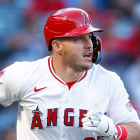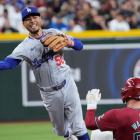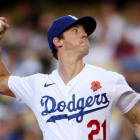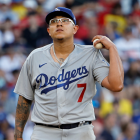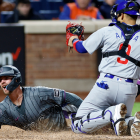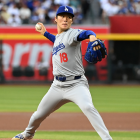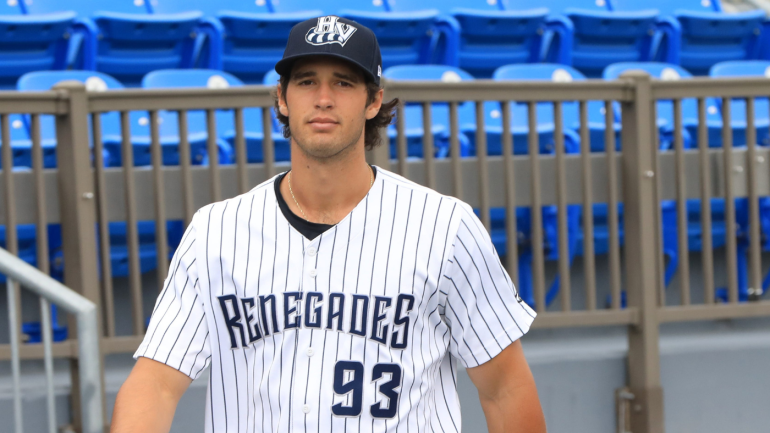
Both the Major and Minor League Baseball seasons are underway, making this as good of a time as any to bring back Prospect Watch. This week's edition, the first of the year, highlights the one prospect in each American League system that we're looking forward to tracking throughout the season. (We'll cover the National League next week.)
To be clear, this is not a roundabout way of identifying the best prospect in each system, though in some cases that individual is exactly who we picked to represent their clubs. Rather, for several teams we picked the player who we felt was most fun to watch, or who we believe has the most riding on this season. There are no wrong answers here, so consider it fair play if you disagree with our selections.
With that out of the way, let's get to the good stuff.
| 1 | |
| SS Jackson Holliday: Last summer's No. 1 pick has proven to be a quick study, even performing well during an extended stay in big-league camp where he faced pitchers with significantly more pro experience than himself. Holliday has plus offensive potential and all of the necessary physical attributes to remain at short. We already ranked Holliday as one of the top 10 prospects in the minors coming into the spring. If his first full season goes as planned, he may celebrate his 20th birthday this December with the top spot in tow. | |
| 2 | |
| CF Miguel Bleis: Bleis just missed cracking the Red Sox top three list over the winter. He's a fairly safe bet to appear on the next edition thanks to his tantalizing upside. His outstanding bat speed hints at well-above-average power potential, and he has enough athleticism that he could remain in center. Bleis just turned 19 in March, giving him plenty of time to refine his approach. A strong showing in his first full-season assignment would go a long way in solidifying his status as one of the most promising outfielders in the business. | |
| 3 | |
| SS Colson Montgomery: Montgomery has long engendered comparisons to Rangers shortstop Corey Seager because of the similarities in their builds, faces, and profiles as lefty-swinging shortstops with power. He's already shown a strong feel for the strike zone and for making quality contact against pro-level pitching, having raced to Double-A in his first full season. The White Sox have shown a willingness to move him along as his play dictates, and so there's a chance he ends up making his big-league debut late in 2023. | |
| 4 | |
| RHP Tanner Bibee: The Guardians are among the best organizations in the sport when it comes to identifying non-elite college arms their developmental staff can get more from. A fifth-round pick in 2021, Bibee has gained velocity since draft night by improving how much he gets into his back side. And he's done so without harming his above-average command over a broad arsenal, including a slider that stands out as his top secondary pitch. Bibee technically spent more than half of last season in Double-A, paving the way for him to make his big-league debut sometime over the course of the first half. | |
| 5 | |
| 3B Colt Keith: Keith was in the midst of a breakout season last June before injuring his shoulder diving back on a pickoff attempt. He's a promising offensive prospect with above-average power from the left side. The questions facing him, besides health, are his position and whether or not he can do enough damage against same-handed pitching to be an everyday player. Here's hoping Keith can stay on the field and provide some answers. | |
| 6 | |
| RHP Forrest Whitley: It wasn't long ago Whitley was considered among the best pitching prospects in the minors. Injuries, suspension, and ineffectiveness have since stalled his career. He's now, at 25 years old and with 40 total innings during the Pandemic Era, just hoping to avoid the waiver wire. Whitley can still touch into the upper-90s with his fastball, but he averaged six walks per nine innings last season. This is the definition of a make-or-break year. | |
| 7 | |
| LHP Frank Mozzicato: You can draw a straight line from the Royals' failure to develop pitching in recent years to the end of Dayton Moore's time presiding over the club. Kansas City spent (and, as it turns out, wasted) a lot of draft capital on arms it couldn't convert into big-league contributors. In other news, Mozzicato struggled in his first professional season, issuing seven walks per nine in A-ball. He skyrocketed up preference lists in 2021, going from an obscure Connecticut lefty to the No. 7 pick in the draft based on the promise offered by his projectable frame and high-grade curve. It's up to this new regime, led by J.J. Picollo, to help Mozzicato live up to his draft status, lest he become a costly final reminder of why Moore is no longer in charge. | |
| 8 | |
| RHP Ben Joyce: There's no great philosophy or nuance behind this pick. We just want to watch Joyce, one of the strongest armed pitchers in the sport, pop mitts with his 100-plus mph heater. He began his professional career last summer in Double-A and remained in big-league camp until the final week, suggesting he should reach the majors sometime during the first half. | |
| 9 | |
| 2B Edouard Julien: If you watched any of Canada's games during the World Baseball Classic, you probably developed a good idea of what Julien is all about. He's not a skilled defender, and he may just be a platoon player in the majors. That established, he can really hit right-handed pitching. The Twins intend to use Byron Buxton at DH early in the season as a means of keeping him healthy. Don't be surprised if Julien ends up getting a lot of run there later in the year. | |
| 10 | |
| OF Spencer Jones: We're living in the golden age of tall outfielders. The Yankees organization, with Aaron Judge and Giancarlo Stanton in tow, is evidence of it. Jones, who barely missed out on the Yankees' top three list, might be the next in line. He's a 6-foot-7 lefty swinger who runs well and who hits the ball very hard. The Yankees were able to pluck him with the 25th pick because other teams had concerns about his strikeout (23.5%) and ground-ball rates (50%) at Vanderbilt; he cut down on that K rate upon moving to the professional ranks, albeit in a small sample. We want to see if Jones can sustain that improvement, because if so, he'll quickly emerge as a Judge-level steal. | |
| 11 | |
| RHP Gunnar Hoglund: Hoglund was one of our favorite arms entering the spring of 2021. Unfortunately, he had to undergo Tommy John surgery that summer, causing him to fall in the draft (albeit only to No. 19) and delaying his professional debut. He's since been traded to the Athletics, with whom he threw eight minor-league innings late last season. Hoglund's command over a broad arsenal should give him a chance to move quickly if he stays healthy. | |
| 12 | |
| RHP Bryce Miller: Here's a developmental win in the making. Miller, a fourth-round pick who barely started at Texas A&M, should make his big-league debut this spring. He's improved his velocity since turning professional, giving him a mid-to-upper-90s hummer that doubles as one of the better fastballs in the minors. Predictably, he showed good bat-missing ability last season, averaging 11 strikeouts per nine in 27 appearances over three levels, including Double-A. Miller's delivery is not particularly graceful, but he's been able to keep his walks in check so far. Should that remain the case, he ought to mature into a mid-rotation starter with a top-shelf offering. | |
| 13 | |
| OF Chandler Simpson: Simpson isn't the best outfield prospect in the Rays system (heck, he's not in the top five), but he should serve as a fascinating case study for what happens when a player with elite speed and 20-grade power is dropped into today's game. He's so fast that he turns even routine plays on the infield into chaotic scrambles. In fact, go on YouTube and you can find a nearly five-minute long highlight reel dedicated to instances where he was, to quote the video's title, "being fast." At the four-minute mark, there's a play where he scores from second on a sacrifice fly to the warning track where the outfielder makes a clean grab and throw without leaving his feet. We're not sure if Simpson will ever make it to the majors, but we're excited to find out. | |
| 14 | |
| RHP Jack Leiter: Leiter, the No. 2 pick in the 2021 draft, had a poor introduction to the professional ranks. He made 23 appearances in Double-A (an aggressive assignment), compiling a 5.54 ERA and a 1.95 strikeout-to-walk ratio. He also missed some time due to arm fatigue -- you know, just to put an even bigger damper on things. Leiter's polish was clearly overstated; we'll find out this year if his supposed great makeup was as well, or if he spent the winter smoothing out the aspects of his game that made for a disappointing first year. | |
| 15 | |
| LHP Ricky Tiedemann: Tiedemann might already be the best left-handed pitching prospect in the sport, depending on how one feels about San Francisco's Kyle Harrison. (CBS Sports had Harrison with a slight edge entering the spring.) He delivers three average or better pitches from a low release point, and he does so while throwing plenty of strikes. It's to be seen if the Blue Jays will let him pitch in the majors this year -- we're talking about someone with fewer than 80 professional innings under their belt -- but even if the answer is no, it'll be worth watching him carve up minor-league foes. | |





























